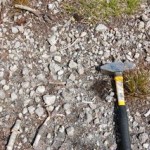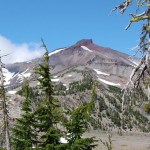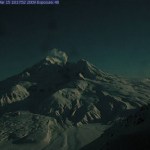Erik Klemetti
I've gotten a number of questions about volcano books as of late, so I thought I'd write a little post detailing my favorite volcano-related tomes, mostly pitched towards people without a geology-background, but some technical books for those of you who want the gory details (and be sure, they can be very, very gory).
Pumice from the Newberry Flow of the Devil's Hills scattered on the soil near South Sister, Oregon. Image by Erik Klemetti, September 2008.
Anyway, here we go!
General volcanology:
- Teach Yourself Volcanoes, Earthquakes and Tsunamis by David Rothery (Teach Yourself Series,…
If you have any questions about volcanoes, pictures of erupting (or not) volcanoes you'd like to share with me for Eruptions or have any general comments, please email me at
. I'd love to hear from you and maybe your question can make it into my next mailbag post (which should hopefully be coming soon.)
While you're at it, feel free to digg, slashdot, technorati or reddit anything you find interesting on Eruptions. You can also follow me on Facebook by clicking the link at the bottom left-hand side of this page (but sorry folks, no Twitter for Eruptions).
Broken Top, near Three Sisters, in…
Starting today and going until early August, you might see fewer posts on Eruptions than you're accustomed. This is because I'm in the process of moving to Ohio to get set up to start my new job as an assistant professor at Denison University. I'm excited about the move, but as you can imagine, trying to pull up stakes in California and trek two-thirds of the way across the continent will take up a lot of my time. I will miss the easy access to volcanoes here on the Left Coast, but I am excited to get (mostly) permanent employment, set up my own lab and to be able to teach geology again!…
I haven't done too many interviews in my day, so this was kind of fun. Wander on over to The Reef Tank and you can read my interview - mostly about the role of water in its many forms on Earth in understanding magmatism and volcanism. Thanks to Ava from The Reef Blog for the interview!
And if you run a blog or website and want to interview me, feel free to drop me a line:
Just a gentle, loving reminder that if you like what you see on Eruptions, why not recommend these articles on your website of choice: Digg, Technorati, Reddit, StumbleUpon, Slashdot, Twitter, whatever. You can also follow Eruptions via Facebook. Click on the link for "Networked Blogs" in the bottom left cover of this page.
Hope you keep enjoying the volcano news!
Happy Birthday, Eruptions!
Well, this definitely snuck up on me, but today marks the one-year anniversary for Eruptions! On May 1, 2008, I started this little blog and if anyone told me that a year later I'd be paid for the gig and getting 50,000 views a month, I would have called them nuts.
So, thank you to all the Eruptions readers and commenters - there are too many to list here, but we've had a blast discussing the eruptions at Chaiten, Redoubt, Hunga Tonga Hunga Ha'apai, Huila, Kasatochi and many many more. It is these discussions that make me realize that this blog is useful,…
Thumbing a nose at Bobby Jindal, we enthusiastically welcome ScienceBlogs newest addition, Eruptions, written by Erik Klemetti. Erik is a post-doc in igneous petrology, which means he studies how the rocks under volcanoes work. Near daily ]posts on Eruptions profile volcanoes in the news, explaining the science behind the eruptions in terms that non-rock heads can understand. At his old digs, he also did some fantastic analysis of the politics and sociology of relocating an entire town from the danger zone around Chaiten volcano. I'm looking forward to more great posts from Erik, and it looks…
Welcome to version 2.0 of Eruptions, the blog on volcanic eruptions and volcano research in general. I've been writing this blog (starting over on Wordpress) over the last year or so, but now it has found a new home here at ScienceBlogs. If you're wondering what to expect if you're new to Eruptions, I'll be bringing news of volcanoes that are erupting worldwide, distilling the scientific jargon, dispelling the misinformation and commenting on what the effects of the eruption(s) might be. I'll also try to bring in any volcanoes in the popular media that gets my attention (alas, it has been…
Welcome to version 2.0 of Eruptions, the blog on volcanic eruptions and volcano research in general. I've been writing this blog (starting over on Wordpress) over the last year or so, but now it has found a new home here at ScienceBlogs. If you're wondering what to expect if you're new to Eruptions, I'll be bringing news of volcanoes that are erupting worldwide, distilling the scientific jargon, dispelling the misinformation and commenting on what the effects of the eruption(s) might be. I'll also try to bring in any volcanoes in the popular media that gets my attention (alas, it has been…
One of the more impressive areas I visited while in New Zealand was the Waimangu Valley near Mt. Tarawera (above). The valley itself was created by blast explosions (phreatic explosions) during the 1886 eruption of Mt. Tarawera. These eruptions cut right down the axis of the rhyolite domes (most of which erupted ~1305 A.D.) and extended off the volcanic edifice to form the valley to the west of the volcano. In the valley, no juvenile lava was erupted, instead explosions carved out large pits that formed the Waimangu Valley and today the valley is filled with lakes and thermal features (below…
Right as Yellowstone is getting interesting (or at least had signs of interest), Eruptions is going on a bit of a break again starting January 2. This time it is because I'm off to the North Island of New Zealand to do some field work. I'll be headed to Tarawera (hopefully both the 1305 and 1886 eruption deposits), Taupo, Tongariro, the area around Rotorua and maybe even White Island (amongst other). I won't have my MacBook, but I will have my iPod Touch, so I'll try to keep track and make brief posts if something big comes up, but feel free to use this post as a clearinghouse for any…
Well, the holidays (and its visitors) have derailed my blogging ability, so in that note, I will officially declare the Eruptions holiday until 12/30. Merry Christmas (or whatever you celebrate) to all the Eruptions readers - and I just hit the 100,000 visit mark, a great Christmas gift for me! - and I'll catch up with some info on Chaiten, St. Helens and whatever volcano news that has happened in the interim.
I've hit the 100th post mark on Eruptions, which isn't too bad for a few months on the blog.
If anyone has any suggestions of what they would like to see more of, less of, or any other changes/suggestions, drop me an email or leave a comment. I'm still fleshing out exactly what this could be, so any input would be appreciated.
Otherwise, enjoy the volcanoes!
I've made it back from my trip to Washington DC. The Smithsonian Institution is quite a fun place to visit, especially if rocks are your ilk. Be sure to check out the wonderful mineral collection at the Natural History Museum. I only wish the Global Volcanism Program would have a more interactive (and visible) spot in the museum itself.
Before we get too far, I wanted to make sure that folks understand that I'm just making educated conjectures on the nature of the eruptions I read about and by no means do I have any extra insight over those scientists on the ground at the eruption. I have a very limited set of data to examine - whatever the media reports - so I am just speculating based on what I know about the eruption style, volcano in question and whatever other variables might come into play. So, please, don't think that I know exactly what is going on or what will happen better than the scientists tackling the…


